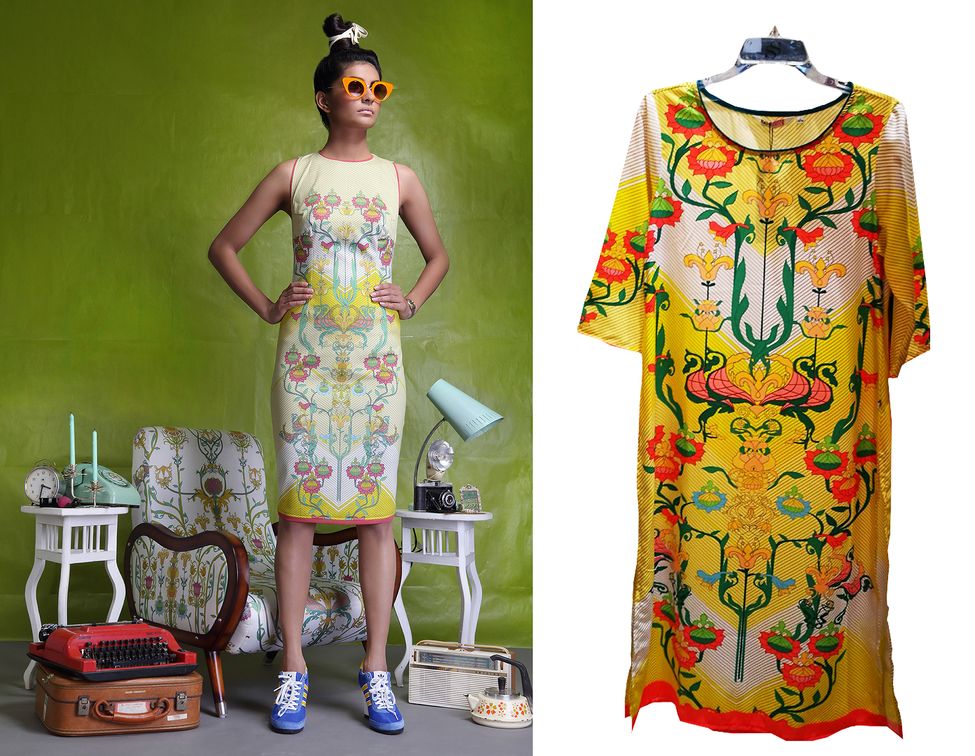Teeming with pictures of her cuddling a kitty, getting drenched in the rain, jumping in the air and showing her fresh collection, the Facebook page of fashion designer Nida Mahmood is delicious. But a couple of weeks ago, the 37-year-old posted a dour Facebook status, accusing a leading retail chain of stealing her designs.
“Recently, when I was doing some window shopping at an airport, I stumbled upon the exact replica of my design with just heightened colours. Instead of a dress, this was a kurta,” Mahmood told THE WEEK. The design in question was part of her Junglee Billee collection that was displayed nearly two years ago.
“On sending a legal notice to them, they shamelessly sent back 10 pages stating that I forfeit my own design if I have used it for a certain period of time and have used it a certain number of times,” an outraged Mahmood wrote on her Facebook wall. “After my legal notice they didn’t have the [guts] to sell the style so all the pieces have been retracted from all the stores in A and B towns and also from their website.”
Mahmood's case is not an exception. The debate over design appropriation and intellectual property is a constant issue in the fashion industry globally. And, the Indian design fraternity is no different, with several instances of designers imitating in the name of ‘inspiration’.
What recently brought the issue to the fore was famed designer Rohit Bal’s social media post slamming a designer, without naming her, for copying his designs. He uploaded an image of his original velvet jacket with floral Kashmiri embroidery next to the rip-off. “Adding her name would be giving her unnecessary publicity,” he wrote on Facebook. “We are surrounded by wannabes and parasitical desperate designers who should really hide their heads in shame and not strip this creative art of all its dignity and respect.”
Bal said he wouldn't let go of the matter easily. “I am compiling a list of many more such designs with images,” he wrote. “There are lots of bigger fish that need to be exposed. All of us, with the FDCI [Fashion Design Council of India], need to try and curb this outright plagiarism. Legally, there is not much we can do since I have tried. The process is long and cumbersome. The only solution is a press expose or some sort of social media campaign.”
 Nida Mahmood's original from the Junglee Billee collection; (right) its replica with a leading retail chain.
Nida Mahmood's original from the Junglee Billee collection; (right) its replica with a leading retail chain.
An upcoming designer, however, said, “At times, established designers copy works of young designers, then accuse them of copying the design and send a legal notice. They stay silent as they are new, don’t know many things and fear that no one will believe their version.” The designer was speaking from personal experience.
Designer Sailesh Singhania said he was simply lucky in proving his innocence when Gaurang Shah accused him of plagiarism early this year. “It was my debut collection and I was shaken. I lost some clients, but had all the proof. So I could prove my innocence. I think some established designers are scared of facing new competition and that is why they do so.”
Fashion designer Rina Dhaka, who invented the lycra leggings, said her innovation had been replicated so much so that it had almost replaced the traditional cotton churidar across the country. “It all started with one of my fellow designers copying my innovation,” she said. “One fine day, this very well-known designer sheepishly told me, 'I can't help [but copy] it [lycra leggings], my customers want it'. I wish I had patented it then.”
What dissuades most designers from patenting their designs is the tedious legal process. Also, Mahmood pointed out that it was almost impossible to copyright a motif, “as one tweak here and there, a change of colour scheme, and it becomes a fresh design. While you can tell it is a stolen design, the variation helps the copier get away legally. And how many designs can you copyright?”
Reportedly, there have seen several instances where fashion biggies have been accused of plagiarism. In 2005, Aki Narula was called a copycat by Suneet Verma. The case is still on. In 2008, Tarun Tahiliani accused Reynu Taandon of stealing his design. In return, Taandon filed a defamation suit against Tahiliani. The case was later amicably resolved. In 2006, Ritu Kumar won a long-drawn case against Nina Talukdar for stealing her sketches, drawings and templates. In 2009, Vikram Phadnis was accused of stealing Abdul Halder’s designs. Recently, Taandon sued a boutique in Shahpur Jat, Delhi, for plagiarism. Even though the process takes time, it is important to take legal action against copycats, said Taandon, “as it will instil fear in them and dissuade them from repeating the same in future”.
In the age of the internet, information (read: pictures of designer collections) travels fast, which serves as fodder for the replica industry, said Dhaka. And, easy availability of fakes is fuelling it. “If markets like Chandni Chowk, Karol Bagh and Lajpat Nagar selling replicas of designer wear were not enough to eat into our business, now there are dedicated e-commerce platforms selling fakes. So, with just a click of the mouse you can get designer wear for one-third its original price,” she said.
What hurts the most is that for a design on which you have invested months of time, energy and hard work, someone copies it just like that and sells for half the price, said Mahmood. It affects the business badly, as your business model gets diluted. If not controlled in time, this will adversely impact the growth of the Indian fashion industry, said designer J.J. Valaya. “A country-centric industry can grow when there is originality.”
Aiming to curb the menace, the FDCI has included lawyer Safir Anand as a special invitee to the board of directors. “So, when such problems arise, we have the legal expertise to find a solution,” said Sunil Sethi, FDCI president. The body also plans to organise seminars to create awareness among designers regarding copyright laws in the country.







